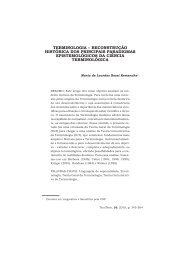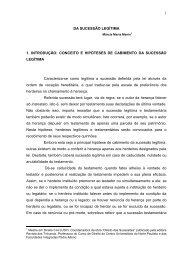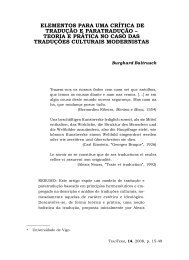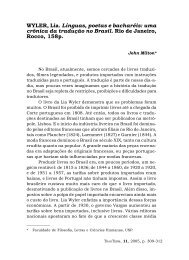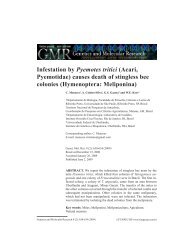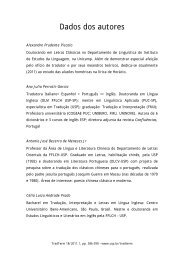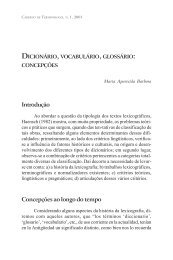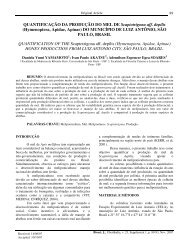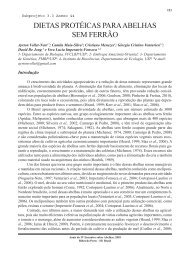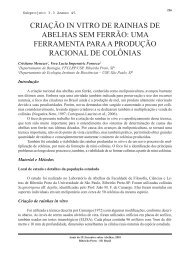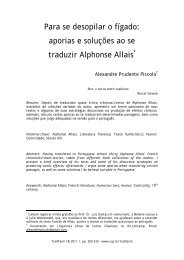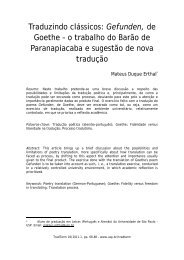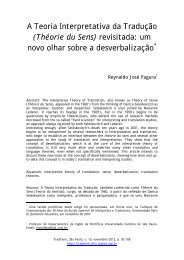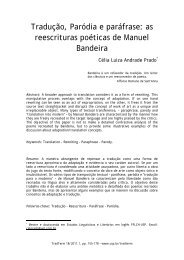Bees as pollinators in Brazil - USP
Bees as pollinators in Brazil - USP
Bees as pollinators in Brazil - USP
Create successful ePaper yourself
Turn your PDF publications into a flip-book with our unique Google optimized e-Paper software.
36<br />
F<strong>in</strong>al remark<br />
The group w<strong>as</strong> composed of a number of<br />
researchers with experience <strong>in</strong> bee surveys<br />
and monitor<strong>in</strong>g. However, the members had<br />
different thoughts about the different methods.<br />
In part, this may be a consequence of the<br />
effect of different environments (<strong>in</strong>clud<strong>in</strong>g<br />
composition of regional bee fauna) on sam-<br />
References<br />
pl<strong>in</strong>g methods. Consequently, methods that<br />
were reported by some <strong>as</strong> very efficient, did<br />
not produce good results <strong>in</strong> other places,<br />
when used by other people. It w<strong>as</strong> suggested<br />
that experiments (like those go<strong>in</strong>g on under<br />
the auspices of the European Poll<strong>in</strong>ator<br />
Initiative) should be made on a regional scale,<br />
so that a f<strong>in</strong>al choice of methods can be made<br />
for each region.<br />
AGOSTI, D., MAJER, J.D., ALONSO, L.E. & SCHULTZ, R. 2000 Biodiversity studies, monitor<strong>in</strong>g and<br />
ants: an overview. In: Ants. Standard methods for me<strong>as</strong>ur<strong>in</strong>g and monitor<strong>in</strong>g biodiversity.<br />
Smithsonian Institution Press. W<strong>as</strong>h<strong>in</strong>gton DC, USA, p. 1-8.<br />
BARROSO, P. A. V. & FREIRE, E. C. 2003. Fluxo gênico em algodão no Br<strong>as</strong>il. In: PIRES, C.S.S.,<br />
FONTES, E.M.G. & SUJII, E. R. Impacto Ecológico de Plant<strong>as</strong> Geneticamente Modificad<strong>as</strong>.<br />
EMBRAPA, Br<strong>as</strong>ília-DF, <strong>Brazil</strong>, p. 163-193.<br />
BATALHA, M. A. 1997. Análise da vegetação da ARIE Cerrado Pé-de-Gigante (Santa Rita do<br />
P<strong>as</strong>sa Quatro, SP). M<strong>as</strong>ters thesis. Universidade de São Paulo, São Paulo-SP, <strong>Brazil</strong>, 185 p.<br />
BUSCHBACHER, R. 2000. Expansão agrícola e perda da biodiversidade no Cerrado: origens<br />
históric<strong>as</strong> e o papel do comércio <strong>in</strong>ternacional. Série Técnica Volume VII .WWF Br<strong>as</strong>il, 104p.<br />
COWELL, R, K. 1997. EstimateS: statistical estimation of species richness and shared species<br />
from samples. Version 5. User’s guide and application. published at http://viceroy.eeb.uconn.edu/<br />
estimates.<br />
FEARNSIDE, P. 2001. Soybean cultivation <strong>as</strong> a threat to the environment <strong>in</strong> <strong>Brazil</strong>. Environmental<br />
Conservation, 28 n.1: 23-38.<br />
FREE, J. B. 1970. Insect poll<strong>in</strong>ation of crops. Academic Press, London, UK, 544 p.<br />
GALINDO-LEAL, C. & CÂMARA, G. I. 2003 The Atlantic Forest of South America: biodiversity<br />
status, threats and outloook. Conservation International Island Press, USA,488p.<br />
KLINK, C. A.. & MOREIRA, A. 2002. P<strong>as</strong>t and current human occupation and land-use In:OLIVEIRA,<br />
P.S. & MARQUIS, R. J. The Cerrado of <strong>Brazil</strong>. Ecology and natural history of a neotropical<br />
savanna. Columbia University Press, New York, USA, p.69-88.<br />
KLINK, C. A. & MACHADO, R.B. 2005. A conservação do Cerrado Br<strong>as</strong>ileiro. Megadiversidade,<br />
1 n.1: 147-155.



